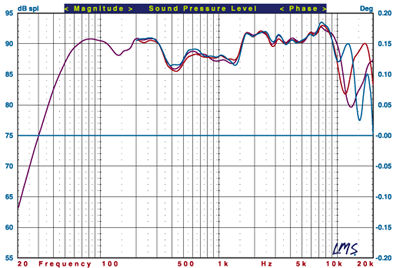Tannoy Dimension surround speaker system Measurements
The Tannoy Dimension TD10 was measured with the foam plugs in its ports. Its sensitivity measured approximately 90dB/W/m, its cabinet is tuned to about 37Hz, and I rate its nominal impedance at 8ohms. The minimum impedance is 2ohms at 11kHz—a frequency where little power is required. There are also wide swings in the impedance phase, but the peak phase deviations are concurrent with relatively high impedance magnitudes. I judge this speaker a moderately difficult load to drive, but no competent amplifier should have trouble with it.
The pseudo-anechoic response of the TD10 at tweeter height, averaged over a 30° forward horizontal angle and combined with the nearfield responses of the woofer and ports, is shown in Fig.1 (violet). The bass rolls off quite rapidly below about 60Hz, with useful bass extending down to about 36Hz (-10dB relative to the output at 80Hz). The on-axis response is smooth, though a dip from 350Hz to 1.5kHz could produce a slightly laid-back sound—as SS notes in the review. The high-frequency response drops off abruptly above 9kHz. On the measurement axis, at the height of the Dual Concentric driver, the SuperTweeter does not appear to help very much in propping up the high-treble response. The curve recovers somewhat above 12kHz or so, but the top octave remains substantially down in level. We also measured the response directly on the SuperTweeter axis (not shown), and while this indicated significant response up to at least 40kHz (we don't trust the response of our measurement microphone much above that), there was still a narrow but significant dip of about -15dB in the measured response at 15kHz.

Fig.1
The horizontal off-axis performance shows a progressively declining level across the mids and highs as you move farther to the side, but apart from this, the overall response remains very similar to the on-axis average.
Fig.2 again shows the TD10's averaged horizontal front response (violet), plus the vertical responses taken at +15° (red) and -15° (blue) relative to the Dual Concentric tweeter axis. Apart from the differences above 10kHz, the tracking of the curves is essentially identical—undoubtedly due to the coaxial design of the Dual Concentric driver.

Fig.2
The TDC center-channel's sealed cabinet is tuned to about 45Hz. I rate its nominal impedance at 7ohms; the minimum impedance was 3.4ohms at 11.5kHz. The speaker's sensitivity measured approximately 94dB/W/m. Like the TD10, the TDC's impedance characteristics suggest that it would not be well matched to an inexpensive receiver—an unlikely pairing in any case. But given the speaker's very high sensitivity, a good, stable amp of even modest power should have no difficulty driving it to high listening levels.
The TDC's averaged front horizontal response is shown in Fig.3 (violet), taken in the same manner as described above for the TD10. The useful bass extension is about 30Hz (-10dB relative to the output at 45Hz). The on-axis response isn't as smooth as the TD10's, though the TDC's response is not as depressed in the upper midrange as the larger speaker's. The wide off-axis response shows some unevenness apart from the expected HF rolloff, particularly at 60° (a very difficult test). The HF response rolls off more slowly than the TD10's, but otherwise shows little positive contribution from the SuperTweeter in the audible range. But SS did note that the SuperTweeters made a clearly audible contribution to the sound of the Tannoy Dimension system.

Fig.3
Like the TD10's, the TDC's ±15° vertical off-axis performance (Fig.4) is good, the responses nearly identical above and below the tweeter.—Thomas J. Norton

Fig.4
- Log in or register to post comments





























































